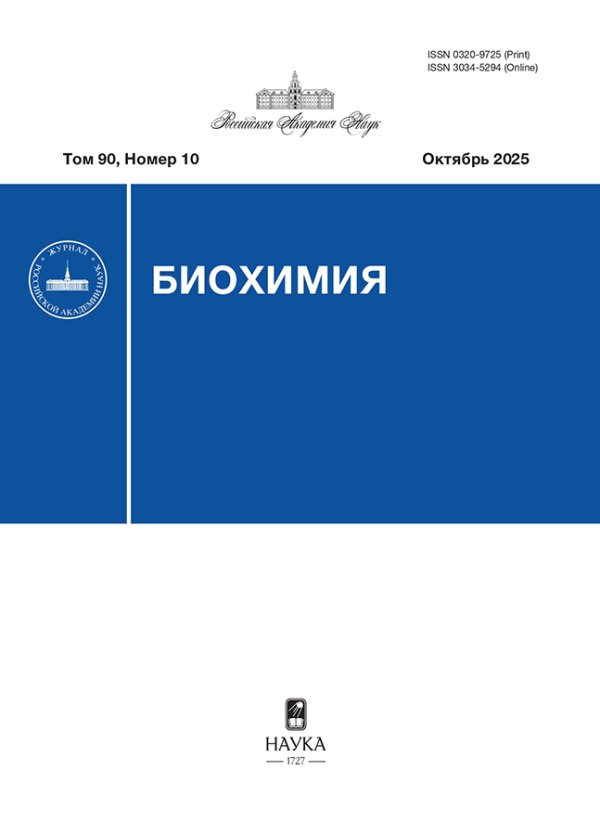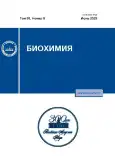Recombinant endopeptidases IdeS and IdeZ and their potential applications
- Authors: Boksha I.S1,2, Lunin V.G1, Danilova T.A1, Poponova M.S1, Polyakov N.B1, Lyashchuk A.M1, Konstantinova S.V1, Galushkina Z.M1, Ustenko E.V1
-
Affiliations:
- The National Research Center for Epidemiology and Microbiology named after Honorary Academician N. F. Gamaleya of the Ministry of Health of the Russian Federation
- Mental Health Research Centre
- Issue: Vol 88, No 6 (2023)
- Pages: 900-912
- Section: Articles
- URL: https://journals.rcsi.science/0320-9725/article/view/144296
- DOI: https://doi.org/10.31857/S0320972523060027
- EDN: https://elibrary.ru/EDQMNB
- ID: 144296
Cite item
Full Text
Abstract
About the authors
I. S Boksha
The National Research Center for Epidemiology and Microbiology named after Honorary Academician N. F. Gamaleya of the Ministry of Health of the Russian Federation;Mental Health Research Centre
Email: boksha_irina@mail.ru
123098 Moscow, Russia;115522 Moscow, Russia
V. G Lunin
The National Research Center for Epidemiology and Microbiology named after Honorary Academician N. F. Gamaleya of the Ministry of Health of the Russian Federation123098 Moscow, Russia
T. A Danilova
The National Research Center for Epidemiology and Microbiology named after Honorary Academician N. F. Gamaleya of the Ministry of Health of the Russian Federation123098 Moscow, Russia
M. S Poponova
The National Research Center for Epidemiology and Microbiology named after Honorary Academician N. F. Gamaleya of the Ministry of Health of the Russian Federation123098 Moscow, Russia
N. B Polyakov
The National Research Center for Epidemiology and Microbiology named after Honorary Academician N. F. Gamaleya of the Ministry of Health of the Russian Federation123098 Moscow, Russia
A. M Lyashchuk
The National Research Center for Epidemiology and Microbiology named after Honorary Academician N. F. Gamaleya of the Ministry of Health of the Russian Federation123098 Moscow, Russia
S. V Konstantinova
The National Research Center for Epidemiology and Microbiology named after Honorary Academician N. F. Gamaleya of the Ministry of Health of the Russian Federation123098 Moscow, Russia
Z. M Galushkina
The National Research Center for Epidemiology and Microbiology named after Honorary Academician N. F. Gamaleya of the Ministry of Health of the Russian Federation123098 Moscow, Russia
E. V Ustenko
The National Research Center for Epidemiology and Microbiology named after Honorary Academician N. F. Gamaleya of the Ministry of Health of the Russian Federation123098 Moscow, Russia
References
- Collin, M. (2001) EndoS, a novel secreted protein from Streptococcus pyogenes with endoglycosidase activity on human IgG, EMBO J., 20, 3046-3055, doi: 10.1093/emboj/20.12.3046.
- Allhorn, M., Olin, A. I., Nimmerjahn, F., and Collin, M. (2008) Human IgG/FcγR interactions are modulated by streptococcal IgG glycan hydrolysis, PLoS One, 3, e1413, doi: 10.1371/journal.pone.0001413.
- Collin, M., Svensson, M. D., Sjöholm, A. G., Jensenius, J. C., Sjöbring, U., and Olsén, A. (2002) EndoS and SpeB from Streptococcus pyogenes inhibit immunoglobulin-mediated opsonophagocytosis, Infect. Immun., 70, 6646-6651, doi: 10.1128/IAI.70.12.6646-6651.2002.
- Wenig, K., Chatwell, L., von Pawel-Rammingen, U., Björck, L., Huber, R., and Sondermann, P. (2004) Structure of the streptococcal endopeptidase IdeS, a cysteine proteinase with strict specificity for IgG, Proc. Natl. Acad. Ssi. USA, 101, 17371-17376, doi: 10.1073/pnas.0407965101.
- Von Pawel-Rammingen, U., Johansson, B. P., Tapper, H., and Björck, L. (2002) Streptococcus pyogenes and phagocytic killing, Nat. Med., 8, 1044-1045, doi: 10.1038/nm1002-1044.
- Von Pawel-Rammingen, U. (2012) Streptococcal IdeS and its impact on immune response and inflammation, J. Innate Immun., 4, 132-140, doi: 10.1159/000332940.
- Spoerry, Ch. (2017) Streptococcal immunoglobulin degrading enzymes of the IdeS and IgdE family, Umeå University, Thesis for: PhD Advisor: von Pawel-Rammingen, Ulrich, Associate Prof., URL: https://www.researchgate.net/publication/320078854_Streptococcal_Immunoglobulin_degrading_Enzymes_of_the_IdeS_and_IgdE_Family.
- Ryan, M. H., Petrone, D., Nemeth, J. F., Barnathan, E., Björck, L., and Jordan, R. E. (2008) Proteolysis of purified IgGs by human and bacterial enzymes in vitro and the detection of specific proteolytic fragments of endogenous IgG in rheumatoid synovial fluid, Mol. Immunol., 45, 1837-1846, doi: 10.1016/j.molimm.2007.10.043.
- Vindebro, R., Spoerry, C., and von Pawel-Rammingen, U. (2013) Rapid IgG heavy chain cleavage by the streptococcal IgG endopeptidase IdeS is mediated by IdeS monomers and is not due to enzyme dimerization, FEBS Lett., 587, 1818-1822, doi: 10.1016/j.febslet.2013.04.039.
- Collin, M., and Björck, L. (2017) Toward clinical use of the IgG specific enzymes IdeS and EndoS against antibody-mediated diseases, Methods Mol. Biol., 1535, 339-351, doi: 10.1007/978-1-4939-6673-8_23.
- Winstedt, L., Järnum, S., Nordahl, E. A., Olsson, A., Runström, A., Bockermann, R., Karlsson, C., Malmström, J., Palmgren, G. S., Malmqvist, U., Björck, L., and Kjellman, C. (2015) Complete removal of extracellular IgG antibodies in a randomized dose-escalation phase I study with the bacterial enzyme IdeS - a novel therapeutic opportunity, PLoS One, 10, e0132011, doi: 10.1371/journal.pone.0132011.
- Jordan, S. C., Lorant, T., Choi, J., Kjellman, C., Winstedt, L., Bengtsson, M., Zhang, X., Eich, T., Toyoda, M., Eriksson, B.-M., Ge, S., Peng, A., Järnum, S., Wood, K. J., Lundgren, T., Wennberg, L., Bäckman, L., Larsson, E., Villicana, R., Kahwaji, J., Louie, S., Kang, A., Haas, M., Nast, C., Vo, A., and Tufveson, G. (2017) IgG Endopeptidase in Highly Sensitized Patients Undergoing Transplantation, N. Engl. J. Med., 377, 442-453, doi: 10.1056/NEJMoa1612567.
- Yang, R., Otten, M. A., Hellmark, T., Collin, M., Bjorck, L., Zhao, M.-H., Daha, M. R., and Segelmark, M. (2010) Successful treatment of experimental glomerulonephritis with IdeS and EndoS, IgG-degrading streptococcal enzymes, Nephrol. Dial. Transplant., 25, 2479-2486, doi: 10.1093/ndt/gfq115.
- Hansa Biopharma AB. (2021) NCT number: NCT02790437. In: https://clinicaltrials.gov/ct2/show/NCT02790437.
- Holden, M. T. G., Heather, Z., Paillot, R., Steward, K. F., Webb, K., Ainslie, F., Jourdan, T., Bason, N. C., Holroyd, N. E., Mungall, K., Quail, M. A., Sanders, M., Simmonds, M., Willey, D., Brooks, K., Aanensen, D. M., Spratt, B. G., Jolley, K. A., Maiden, M. C., Kehoe, M., Chanter, N., Bentley, S. D., Robinson, C., Maskell, D. J., Parkhill, J., and Waller, A. S. (2009) Genomic evidence for the evolution of Streptococcus equi: host restriction, increased virulence, and genetic exchange with human pathogens, PLoS Pathog., 5, e1000346, doi: 10.1371/journal.ppat.1000346.
- Hulting, G., Flock, M., Frykberg, L., Lannergård, J., Flock, J.-I., and Guss, B. (2009) Two novel IgG endopeptidases of Streptococcus equi, FEMS Microbiol. Lett., 298, 44-50, doi: 10.1111/j.1574-6968.2009.01698.x.
- Lannergård, J., and Guss, B. (2006) IdeE, an IgG-endopeptidase of Streptococcus equi ssp. equi, FEMS Microbiol. Lett., 262, 230-235, doi: 10.1111/j.1574-6968.2006.00404.x.
- Boksha, I. S., Lavrova, N. V., Grishin, A. V., Demidenko, A. V., Lyashchuk, A. M., Galushkina, Z. M., Ovchinnikov, R. S., Umyarov, A. M., Avetisian, L. R., Chernukha, M. Iu., Shaginian, I. A., Lunin, V. G., and Karyagina, A. S. (2016) Staphylococcus simulans recombinant lysostaphin: production, purification, and determination of antistaphylococcal activity, Biochemistry (Moscow), 81, 502-510, doi: 10.1134/S0006297916050072.
- An, Y., Zhang, Y., Mueller, H.-M., Shameem, M., and Chen, X. (2014) A new tool for monoclonal antibody analysis, MAbs, 6, 879-893, doi: 10.4161/mabs.28762.
- Machacek, M., Fields, P. E., and Slawson, C. (2020) A proteolytic method for evaluating O-GlcNAcylation on proteins of similar molecular weight to antibody heavy chain after immunoprecipitation, Anal. Biochem., 611, 114001, doi: 10.1016/j.ab.2020.114001.
- Kizlik-Masson, C., Deveuve, Q., Zhou, Y., Vayne, C., Thibault, G., McKenzie, S. E., Pouplard, C., Loyau, S., Gruel, Y., and Rollin, J. (2019) Cleavage of anti-PF4/heparin IgG by a bacterial protease and potential benefit in heparin-induced thrombocytopenia, Blood, 133, 2427-2435, doi: 10.1182/blood.2019000437.
- Gruel, Y., Vayne, C., Rollin, J., and Pouplard, C. (2021) Reply to the letter entitled "Suggested treatment of serious complications to Covid-19 vaccination with IdeS, a bacterial antibody-cleaving enzyme", J. Thromb. Haemost., 19, 2632, doi: 10.1111/jth.15465.
- Kahn, F., Shannon, O., and Björck, L. (2021) Suggested treatment of serious complications to COVID-19 vaccination with IdeS, a bacterial antibody-cleaving enzyme, J. Thromb. Haemost., 19, 2363-2364, doi: 10.1111/jth.15433.
- Lonze, B. E., Tatapudi, V. S., Weldon, E. P., Min, E. S., Ali, N. M., Deterville, C. L., Gelb, B. E., Benstein, J. A., Dagher, N. N., Wu, M., and Montgomery, R. A. (2018) IdeS (Imlifidase): A novel agent that cleaves human igg and permits successful kidney transplantation across high-strength donor-specific antibody, Ann. Surg., 268, 488-496, doi: 10.1097/SLA.0000000000002924.
- Runström, A., Järnum, S., Jordan, S., Winstedt, L., and Kjellman, C. (2018) Antibodies in IVIg and its effect on IdeS activity, American Transplant. Congr., A156, URL: https://atcmeetingabstracts.com/abstract/anti-ides-antibodies-in-ivig-and-its-effect-on-ides-activity/.
- Åkesson, P., Rasmussen, M., Mascini, E., von Pawel-Rammingen, U., Janulczyk, R., Collin, M., Olsen, A., Mattsson, E., Olsson, M. L., Bjorck, L., and Christensson, B. (2004) Low antibody levels against cell wall-attached proteins of Streptococcus pyogenes predispose for severe invasive disease, J. Infect. Dis., 189, 797-804, doi: 10.1086/381982.
- Elmore, Z. C., Oh, D. K., Simon, K. E., Fanous, M. M., and Asokan, A. (2020) Rescuing AAV gene transfer from neutralizing antibodies with an IgG-degrading enzyme, JCI Insight, 5, e139881, doi: 10.1172/jci.insight.139881.
- Robinson, C., Frykberg, L., Flock, M., Guss, B., Waller, A. S., and Flock, J.-I. (2018) Strangvac: a recombinant fusion protein vaccine that protects against strangles, caused by Streptococcus equi, Vaccine, 36, 1484-1490, doi: 10.1016/j.vaccine.2018.01.030.
- Hashikawa, S., Iinuma, Y., Furushita, M., Ohkura, T., Nada, T., Torii, K., Hasegawa, T., and Ohta, M. (2004) Characterization of group C and G streptococcal strains that cause streptococcal toxic shock syndrome, J. Clin. Microbiol., 42, 186-192, doi: 10.1128/JCM.42.1.186-192.2004.
- Bradley, S. F., Gordon, J. J., Baumgartner, D. D., Marasco, W. A., and Kauffman, C. A. (1991) Group C streptococcal bacteremia: analysis of 88 cases, Clin. Infect. Diseases, 13, 270-280, doi: 10.1093/clinids/13.2.270.
- Downar, J., Willey, B. M., Sutherland, J. W., Mathew, K., and Low, D. E. (2001) Streptococcal meningitis resulting from contact with an infected horse, J. Clin. Microbiol., 39, 2358-2359, doi: 10.1128/JCM.39.6.2358-2359.2001.
- Abbott, Y., Acke, E., Khan, S., Muldoon, E. G., Markey, B. K., Pinilla, M., Leonard, F. C., Steward, K., and Waller, A. (2010) Zoonotic transmission of Streptococcus equi subsp. zooepidemicus from a dog to a handler, J. Med. Microbiol., 59, 120-123, doi: 10.1099/jmm.0.012930-0.
- Waller, A. S., and Robinson, C. (2013) Streptococcus zooepidemicus and Streptococcus equi evolution: the role of CRISPRs, Biochem. Soc. Trans., 41, 1437-1443, doi: 10.1042/BST20130165.
- Björnsdóttir, S., Holden, M. T. G., Svansson, V., Harris, S. R., Webb, K., Robinson, C., Steward, K. F., Wright, N., Paillot, R., Newton, J. R., Gunnarsson, E., and Waller, A. S. (2012) Streptococcus zooepidemicus: more than just an opportunist? J. Equine Vet. Sci., 32, S8, doi: 10.1016/j.jevs.2012.08.024.
- De Negri, R. (2013) Equine Serum Antibody Responses to Streptococcus Equi and Streptococcus Zooepidemicus, Theses and Dissertations - Veterinary Science, 13, University of Kentucky, URL: https://uknowledge.uky.edu/gluck_etds/13.
- Priestnall, S., and Erles, K. (2011) Streptococcus zooepidemicus: An emerging canine pathogen, Vet. J., 188, 142-148, doi: 10.1016/j.tvjl.2010.04.028.
- Pisoni, G., Zadoks, R. N., Vimercati, C., Locatelli, C., Zanoni, M. G., and Moroni, P. (2009) Epidemiological investigation of Streptococcus equi subspecies zooepidemicus involved in clinical mastitis in dairy goats, J. Dairy Sci., 92, 943-951, doi: 10.3168/jds.2008-1548.
- Pelkonen, S., Lindahl, S. B., Suomala, P., Karhukorpi, J., Vuorinen, S., Koivula, I., Väisänen, T., Pentikäinen, J., Autio, T., and Tuuminen, T. (2013) Transmission of Streptococcus equi subspecies zooepidemicus infection from horses to humans, Emerg. Infect. Dis., 19, 1041-1048, doi: 10.3201/eid1907.121365.
- Baiter, S., Benin, A., Pinto, S. W. L., Teixeira, L. M., Alvim, G. G., Luna, E., Jackson, D., LaClaire, L., Elliott, J., Facklam, R., and Schuchat, A. (2000) Epidemic nephritis in Nova Serrana, Brazil, Lancet, 355, 1776-1780, doi: 10.1016/S0140-6736(00)02265-0.
- Javed, R., Taku, A. K., Gangil, R., and Sharma, R. K. (2016) Molecular characterization of virulence genes of Streptococcus equi subsp. equi and Streptococcus equi subsp. zooepidemicus in equines, Vet. World, 9, 875-881, doi: 10.14202/vetworld.2016.875-881.
- Velineni, S., and Timoney, J. F. (2013) Identification of novel immunoreactive proteins of Streptococcus zooepidemicus with potential as vaccine components, Vaccine, 31, 4129-4135, doi: 10.1016/j.vaccine.2013.06.100.
Supplementary files










